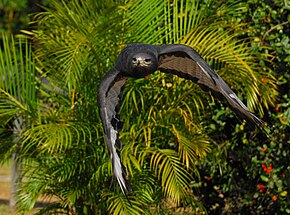Augur buzzard
| Augur buzzard | |
|---|---|
 |
|
| Dark-morph augur buzzard (B. augur) | |
| Scientific classification | |
| Kingdom: | Animalia |
| Phylum: | Chordata |
| Class: | Aves |
| Order: | Accipitriformes |
| Family: | Accipitridae |
| Genus: | Buteo |
| Species: | B. augur |
| Binomial name | |
|
Buteo augur (Rüppell, 1836) |
|
 |
|
| Global range Year-Round Range Summer Range Winter Range | |
The augur buzzard (Buteo augur) is a 55–60 cm long African bird of prey. The taxonomy on this species is confusing, with some taxonomists considering this species, the jackal buzzard, and the Archer's buzzard to be the same superspecies. Many taxonomists consider them all to be distinct, having different calls, different home ranges and variations in plumage. This is a species of mountains (most typically at about 2000 m altitude, but up to 5000 m), and adjacent savannah and grassland. It is resident and non-migratory throughout its range. It is normally found from Ethiopia to southern Angola and central Namibia. This species is also the Seattle Seahawks mascot
The adult augur buzzard is strikingly plumaged. It is almost black above with a rufous tail. The primary flight feathers are blackish and the secondaries off-white, both barred with black. Below the chin and around the throat is mainly white, and the rest of the underparts and the underwing coverts are rich rufous. The flight feathers from below are white, tipped with black to form a dark trailing edge to the wing.
The juvenile augur buzzard is mainly brown above and rufous brown below and on the tail. It can be confused with wintering steppe buzzard, but has broader wings and an unbarred undertail.
The adult augur buzzard has white underparts and underwings. The female has black on the lower throat. Juveniles are brown above and buff below, the underparts later becoming white. There is a melanistic form of augur buzzard, all black, except for grey and black-barred flight feathers and a chestnut tail. About 10% of birds are melanistic, but the proportion rises in forested areas with high rainfall to as much as 50% in some areas.
Pairs have noisy aerial displays, including outside the breeding season. The large (up to 1 m wide) stick nest is built in a tree or on a crag, and is often reused and enlarged in subsequent seasons. Two creamy or bluish white eggs are laid and incubated by the female only, although food is brought to her on the nest by the male.
The eggs hatch in about 40 days, and after a further 56–60 days the chicks can attempt flight. At 70 days they become independent of the nest, but young birds may then be seen with the adult pair for some time.
...
Wikipedia

